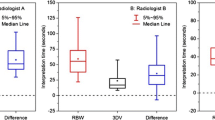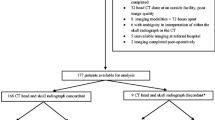Abstract
Purpose
The purpose of this study was to determine the accuracy of “black bone” (BB) MRI for the detection of skull fractures in children with potential abusive head trauma.
Methods
A total of 34 pediatric patients were evaluated for potential abusive head trauma. All patients had both a non-contrast head CT (HCT) with multiplanar reformatted images and 3D volumetric reformatted images where available (gold standard) for fracture diagnosis and BB of the head with multiplanar reformatted images and 3D volumetric images. BB was performed using an ultrashort TE pointwise encoding time reduction with radial acquisition (PETRA) sequence at 1.5 T or 3 T. BB datasets were post-processed and 3D images created using Fovia’s High Definition Volume Rendering® software. Two board-certified pediatric neuroradiologists independently reviewed the HCT and BB imaging, blinded to the findings from the other modality.
Results
Median patient age was 4 months (range 1.2–30 months). A total of 20 skull fractures in six patients (18% incidence of skull fractures) were detected on HCT. BB demonstrated 83% sensitivity (95%[CI] 36–99%), 100% specificity (95%[CI] 88–100%), 100% PPV (95%[CI] 46–100%), 97% NPV (95%[CI] 82–99%), and 97% accuracy (95%[CI] 85–99%) for diagnosis of a skull fracture. BB detected 95% (19/20) of the skull fractures detected by CT.
Conclusion
A black bone MRI sequence may provide high sensitivity and specificity for detection of skull fractures in pediatric patients with abusive head trauma.



Similar content being viewed by others
Abbreviations
- UTE:
-
Ultrashort TE
- PETRA:
-
Pointwise encoding time reduction with radial acquisition
- HCT:
-
Head CT
- AHT:
-
Abusive head trauma
References
Niederkrotenthaler T, Xu L, Parks SE, Sugerman DE (2013) Descriptive factors of abusive head trauma in young children: United States, 2000–2009. Child Abuse Negl 37:446–455
Duhaime AC, Christian C, Moss E, Seidl T (1996) Long-term outcome in infants with the shaking-impact syndrome. Pediatr Neurosurg 24(6):292–298
Chevignard MP, Lind K (2014) Long-term outcome of abusive head trauma. Pediatr Radiol 44(Suppl 4):S548–S558
Reece RM, Sege R (2000) Childhood head injuries: accidental or inflicted? Arch Pediatr Adolesc Med 154(1):11–15
Sills MR, Libby AM, Orton HD (2005) Prehospital and in-hospital mortality: a comparison of intentional and unintentional traumatic brain injuries in Colorado children. Arch Pediatr Adolesc Med 159(7):665–670
Jaspan T, Griffiths PD, McConachie NS et al (2003) Neuroimaging for non-accidental head injury in childhood: a proposed protocol. Clin Radiol 58(1):44–53
Ginde AA, Foianini A, Renner DM, Valley M, Camargo CA (2008) Availability and quality of computed tomography and magnetic resonance imaging equipment in U.S. emergency departments. Acad Emerg Med 15(8):780–783
Hedlund GL, Frasier LD (2009) Neuroimaging of abusive head trauma. Forensic Sci Med Pathol 5(4):280–290
Eley KA, McIntyre AG, Watt-Smith SR, Golding SJ (2012) “Black bone” MRI: a partial flip angle technique for radiation reduction in craniofacial imaging. Br J Radiol 85(1011):272–278
Eley KA, Watt-Smith SR, Golding SJ (2012) “Black bone” MRI: a potential alternative to CT when imaging the head and neck: report of eight clinical cases and review of the Oxford experience. Br J Radiol 85(1019):1457–1464
Eley KA, Watt-Smith SR, Sheerin F, Golding SJ (2014) “Black bone” MRI: a potential alternative to CT with three-dimensional reconstruction of the craniofacial skeleton in the diagnosis of craniosynostosis. Eur Radiol 24(10):2417–2426
Eley KA, Watt-Smith SR, Golding SJ (2013) “Black bone” MRI: a potential non-ionizing method for three-dimensional cephalometric analysis—a preliminary feasibility study. Dentomaxillofac Radiol 42(10):20130236
Eley KA, Watt-Smith SR, Golding SJ (2017) Three dimensional reconstruction of the craniofacial skeleton with gradient echo magnetic resonance imaging (“black bone”): what is currently possible? J Craniofac Surg 28(2):463–467
Eley KA, Watt-Smith SR, Golding SJ (2017) “Black bone” MRI: a novel imaging technique for 3D printing. Dentomaxillofac Radiol 46(3):20160407
Orman G, Wagner MW, Seeburg D, Zamora CA, Oshmyansky A, Tekes A, Poretti A, Jallo GI, Huisman TAGM, Bosemani T (2015) Pediatric skull fracture diagnosis: should 3D CT reconstructions be added as routine imaging? J Neurosurg Pediatr 16(4):426–431
Dremmen MHG, Wagner MW, Bosemani T, Tekes A, Agostino D, Day E, Soares BP, Huisman TAGM (2017) Does the addition of a "black bone" sequence to a fast multisequence trauma MR protocol allow MRI to replace CT after traumatic brain injury in children? AJNR Am J Neuroradiol 38(11):2187–2192
Fleiss JL (1971) Measuring nominal scale agreement among many raters. Psychol Bull 76:378–382
Brenner D, Elliston C, Hall E, Berdon W (2001) Estimated risks of radiation-induced fatal cancer from pediatric CT. AJR Am J Roentgenol 176(2):289–296
Ida M, Wakayama T, Nielsen ML, Abe T, Grodzki DM (2015) Quiet T1-weighted imaging using PETRA: initial clinical evaluation in intracranial tumor patients. J Magn Reson Imaging 41(2):447–453
Serai SD, Laor T, Dwek JR, Zbojniewicz AM, Carl M (2014) Feasibility of ultrashort TE (UTE) imaging of children at 1.5 T. Pediatr Radiol 44(1):103–108
Greenes DS, Schutzman SA (2001) Clinical significance of scalp abnormalities in asymptomatic head-injured infants. Pediatr Emerg Care 17(2):88–92
Dunning J, Daly JP, Lomas JP, Lecky F, Batchelor J, Mackway-Jones K, on behalf of the Children’s Head Injury Algorithm for the Prediction of Important Clinical Events (CHALICE) study group (2006) Derivation of the children’s head injury algorithm for the prediction of important clinical events decision rule for head injury in children. Arch Dis Child 91(11):885–891
Schutzman SA, Greenes DS (2001) Pediatric minor head trauma. Ann Emerg Med 37(1):65–74
Kralik SF, Yasrebi M, Supakul N, Lin C, Netter LG, Hicks RA, Hibbard RA, Ackerman LL, Harris ML, Ho CY (2017) Diagnostic performance of ultrafast brain MRI for evaluation of abusive head trauma. AJNR Am J Neuroradiol 38(4):807–813
Author information
Authors and Affiliations
Corresponding author
Ethics declarations
Funding
No funding was received for this study.
Conflict of interest
GD is employed by GE Healthcare.
Ethical approval
All procedures performed in the studies involving human participants were in accordance with the ethical standards of the institutional and/or national research committee and with the 1964 Helsinki Declaration and its later amendments or comparable ethical standards.
Informed consent
For this type of retrospective study formal consent is not required.
Rights and permissions
About this article
Cite this article
Kralik, S.F., Supakul, N., Wu, I.C. et al. Black bone MRI with 3D reconstruction for the detection of skull fractures in children with suspected abusive head trauma. Neuroradiology 61, 81–87 (2019). https://doi.org/10.1007/s00234-018-2127-9
Received:
Accepted:
Published:
Issue Date:
DOI: https://doi.org/10.1007/s00234-018-2127-9




